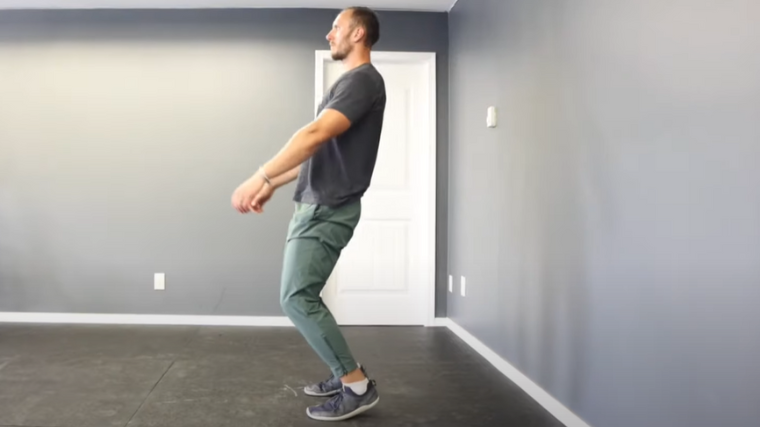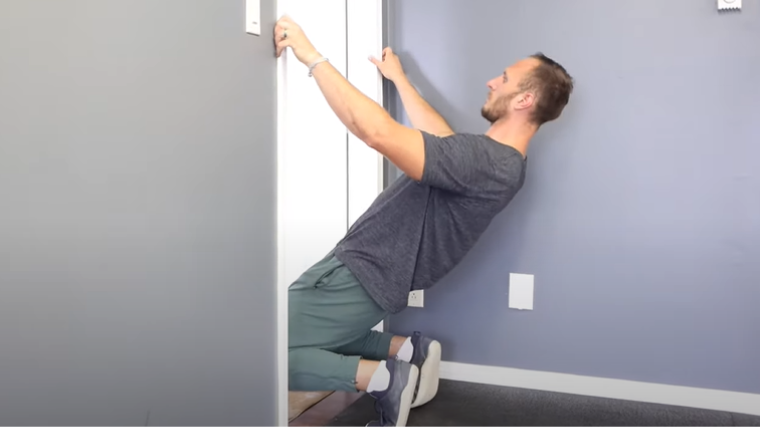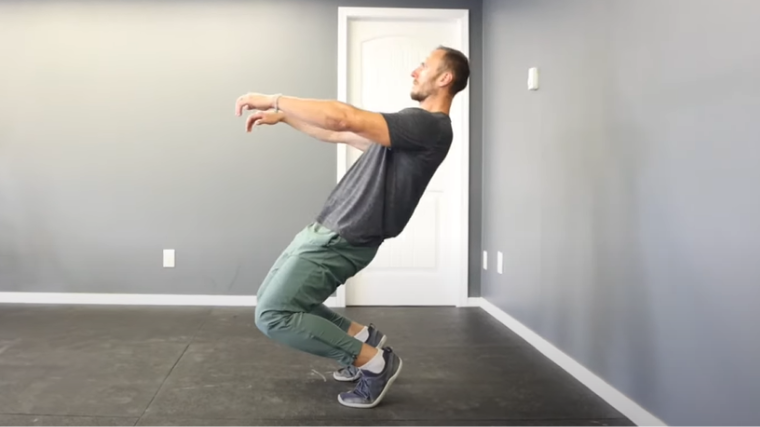If you’ve been on the prowl for a new way to grow your quads, or your mind is addled by the delusion that bodyweight movements can’t grow muscle, you’re in for a real treat.
The sissy squat, despite its namesake, is one of the most deceptively challenging — and humbling — bodyweight exercises out there. It also happens to be a phenomenal exercise for growing your legs.
Whether you’re bored of the barbell or need to make (or keep) your gains while you’re on the road or stuck in the office, the sissy squat might just be what you’ve been looking for.
- How to Do the Sissy Squat
- Sissy Squat Sets and Reps
- Common Sissy Squat Mistakes
- Sissy Squat Variations
- Sissy Squat Alternatives
- Muscles Worked by the Sissy Squat
- Benefits of the Sissy Squat
- Who Should Do the Sissy Squat
- Frequently Asked Questions
How to Do the Sissy Squat
Unfortunately, the easiest part of the sissy squat is the setup. To prepare for the movement, all you need is your own body and perhaps something sturdy to hold onto, such as a squat rack or PVC pipe for balance.
Step 1 — Dip and Reach

Start by standing upright in a clear area with your feet under your hips. Initiate the movement by bending your knees and beginning to lean backward slowly, while also releasing your heels from the ground.
Coach’s Tip: Try to raise your arms out in front of you at the same cadence as your knees bend to help maintain your balance.
Step 2 — Sink Low

Next, continue to descend in the same manner until you reach your movement tolerance. If you’re still learning the exercise, you can hold onto a door frame, a barbell held in a rack, or other stable fixture to help with your balance.
Coach’s Tip: If you’re using a support structure, keep your grip on it very light so your body does most of the work.
Step 3 — Pause and Stand

Once you’ve dipped as low as possible, or your knees are far ahead of your toes, pause for a moment to stabilize errant movement. Then, reverse the motion and return to a standing position.
Coach’s Tip: Contract your quads hard to stand up instead of flailing your arms or rocking your shoulders.
Sissy Squat Sets and Reps
Bodyweight exercises like the sissy squat are quite malleable in terms of programming. There’s a lot you can do with the exercise beyond using it to beef up your quads.
Here are a couple different ways to cut the proverbial cake, depending on your needs:
- As a Beginner: 2-3 sets of up to 5 reps, focusing on your technique.
- For Muscle Growth: 3-4 sets of as many reps as needed to reach a Rate of Perceived Exertion (RPE) of at least a 7.
- For Strength & Stability: up to 5 sets of 3 slow and controlled reps.
Common Sissy Squat Mistakes
Falling on your behind is a far more likely outcome than blowing out your kneecaps, despite how the sissy squat looks at a glance. The exercise is far from dangerous, but you should still be mindful of what can go wrong, and be aware of any execution errors that may prevent you from making gains.
Not Bracing Your Torso
To perform the sissy squat effectively, you need to have a stable and locked-in trunk. This means ensuring that your hips are in extension (think about squeezing your buttocks the whole time) and that you’re circumferentially bracing your core.
Inhibiting Knee Travel
By its very nature, the sissy squat necessitates that your knees travel far in advance of your toes. There’s absolutely nothing wrong with forward knee travel as it relates to joint health or stability — so don’t be afraid to let your knees track forward.
Note, though, that you should never force yourself into a range of motion that is particularly uncomfortable. Be mindful of what sensations qualify as challenging and which might be painful.
If you experience notable pain at any point, cease the exercise and consider consulting your physician.
Leaning Too Far Back
Calisthenics are all about balance. While your torso does need to lean backward as your knees track forward to keep your center of mass in alignment, don’t force this so much that you feel yourself falling over.
The sissy squat is not a game of limbo. Lean back just enough that you can balance yourself.
Sissy Squat Variations
If you’re wary of jumping into the sissy squat proper, there are plenty of ways to modify the movement and grade your exposure. You can make it easier, harder, and everything in-between.
Band-Assisted Sissy Squat
You can fix a resistance band to a stable surface (a squat or power rack would do nicely) and utilize the band’s elastic tension to help you balance yourself.
A band-assisted sissy squat will be easier to learn and perform with a full range of motion, but it might make the standard version of the exercise a bit awkward in terms of feel, since you don’t have the tension of the band to counteract your own weight.
Weighted Sissy Squat
You can load the sissy squat with a small amount of weight, though it’s certainly not necessary to do so for the movement to be effective.
However, you should be very cognizant of how you apply external resistance. The weight you’re using shouldn’t affect your technique or throw you off balance.
A light weight vest or a small kettlebell held in one hand would be a good starting point, but advanced athletes can consider performing the movement in a Smith machine as well.
Kneeling Sissy Squat
If you find most versions of the sissy squat too difficult — nevermind the baseline iteration — you can take things back to ground level, literally, by performing the motion from a kneeling position.
Provided you can sit on your knees, extending yourself up to a full kneeling position will replicate a portion of the range of motion of the sissy squat. This variation can serve as an effective introductory stressor to knee-based calisthenics.
Sissy Squat Alternatives
If the sissy squat makes you queasy or you aren’t particularly into bodyweight-only training, try out some of these alternatives. They replicate some of the sissy squat’s mechanics, but allow you more flexibility in how you load and progress your legs.
Spanish Squat
The Spanish squat is similar to the sissy squat in design, but also partly resembles a hack squat. As long as you have access to a heavy-duty resistance band, you can stabilize your lower legs and sit down and back to load your quads.
Holding onto a heavy kettlebell or dumbbell in the front rack position works well as a loading scheme.
Cyclist Squat
For quad stimulation above all, turn to the cyclist squat. It’s essentially the same motion as the sissy squat, but doesn’t challenge your balance or trunk stability nearly as much.
Placing your heels on a high elevation (think 2-3 inches) affords you an extreme amount of forward knee travel. You can perform cyclist squats with dumbbells in your hands or a barbell on your back. The quad pump will be otherworldly.
Pistol Squat
If you want to challenge your quads without using weights and become freakishly acrobatic at the same time, give the pistol squat a go.
It’s essentially a single-legged bodyweight squat. Sounds easy on paper, but is devilishly tricky to execute well in practice. Moreover, lumping all your body’s weight onto one leg puts a huge amount of stress onto the quads.
Muscles Worked by the Sissy Squat
It may not be a smorgasbord of muscle activation, but the sissy squat is more than just an admittedly phenomenal quadricep builder.
There’s actually some interesting anatomical science at play as well that makes the sissy squat particularly valuable if you’re interested in comprehensive, well-rounded muscle growth.
Quadriceps
Your quads are the prime (and, for the most part, only) mover in the sissy squat, as the exercise is based almost entirely around knee flexion and extension.
Since your quadriceps are the only muscle that act to facilitate that motion, they’ll take on the entirety of the tension and force as you sink into each and every rep.
Rectus Femoris
Your rectus femoris is one of the four compartments that make up the quadricep. However, unique to the rectus femoris is the fact that it is a biarticular muscle — it crosses more than one joint.
The tissue actually originates on the pelvis and inserts on the tibia, meaning it crosses both the hip and knee joints.
Biomechanically speaking, this means you might get a bit more rectus femoris activation in the sissy squat compared to other leg exercises like the barbell squat or leg press.
The sissy squat is one of the only quad exercises out there that has you bend and straighten your knee while your hip is locked in place, providing some extra stretch to the rectus femoris.
Core
It may not necessarily be a core exercise per se, but the sissy squat will challenge your abs isometrically during each rep you perform.
A braced, secure torso is crucial to maintaining your balance throughout the exercise — a demand which falls squarely on your abdominals, obliques, and lower back to a degree as well.
Ankles
Okay, your ankles aren’t a muscle. However, the various tissues that surround and encapsulate the ankle joint will be tested by the sissy squat, since you perform the exercise up on the balls of your feet.
[Read More: The Best Ab Exercises & Workouts, According to a CPT]
This artificially creates a tremendous amount of ankle dorsiflexion, which may be uncomfortable in some cases. Be mindful of this if you’re working through an ankle or foot injury, as you may not have the tolerance to undertake the sissy squat just yet.
Benefits of the Sissy Squat
It (probably) isn’t the only exercise you’ll ever need for building up your quads, but the sissy squat has a surprising amount going for it that help it stand out from the pack when you’re building your workout routine.
Quad-Focused Muscle Growth
Far and away the biggest benefit of the sissy squat is how effective it is at targeting your quads. By removing your hips from the equation, the surrounding musculature is put on the sidelines and all tension is applied directly to your knee extensors.
Even if you aren’t using any additional weight, you should find it more than adequate to challenge your quads to grow.
Teaches Dynamic Balance
As a side benefit, the sissy squat is a great way to learn (and demonstrate at a party if you’re brave enough) to balance yourself. It takes a surprising amount of fine motor control, patience, and proprioception to execute well.
Who Should Do the Sissy Squat
It’s certainly not for everyone, but the sissy squat definitely isn’t for no one either — and it might just be perfect for you, depending on your needs.
Bodybuilders
If your goal is muscle growth (or hitting up a physique competition someday), you can use the sissy squat as a finisher at the end of your leg workouts to ensure every drop of juice has been squeezed out of your quads.
Or, stick it at the beginning of your session as both a dynamic warm-up movement and a primer for your legs.
Those Without Gym Access
Bodyweight movements can be surprisingly effective for maintaining your muscle and strength if you’re away from the weight room for an extended period.
If you’re stuck at the office all day, you can perform a few sets of sissy squats during your lunch break. Or, if you’re traveling, do them at the airport to keep your legs warm between flights.
Bodyweight Trainees
Calisthenics devotees tend to struggle most with developing their legs, simply because they’re constrained to only working with gravity as resistance, and the quads can take quite a beating.
View this post on Instagram
[Related: Best Cross-Training Shoes]
As such, you have to get creative about how you load your legs if you like to train with only your bodyweight.
Hand in hand with an exercise like the Nordic curl for your hamstrings, the sissy squat applies a lot of mechanical tension to your quads without requiring a bunch of weights to do so.
Sissy Squats for Size and Strength
Frankly, the sissy squat is one of the most dubiously-named exercises out there. It’s far from a walk in the park, even if you’ve spent quite a while in the gym already.
Luckily, that’s what makes it so effective. You can use the sissy squat to strengthen your knees, grow your legs, or temper your balance and stability — all without having to lift a single weight.
FAQs
Still have questions about the sissy squat? No problem. We’ve got answers.
Are sissy squats bad for my knees?
No. While your knee does travel far ahead of your toe in the sissy squat, this isn’t an inherently dangerous position for the joint.
Your best bet is to introduce sissy squats to your exercise routine slowly, perhaps via a modification or variation, if your knees are sensitive to mechanical tension.
Can I do sissy squats with weight?
Technically, yes. However, the technique of the sissy squat makes it perfectly challenging on its own.
You may not need extra weights to make the movement sufficiently challenging, especially if you commit to using a full range of motion.
Is the sissy squat safe for beginners?
Yes. It may not be a true beginner’s movement — consider a bodyweight or box squat instead — but newbie gymgoers and calisthenics enthusiasts can definitely kick off their training with the sissy squat.
Featured Image: @wsoo_mvmt on Instagram